-
Posts
14,343 -
Joined
-
Last visited
-
Days Won
25
Content Type
Profiles
Forums
Blogs
Gallery
Events
Store
Posts posted by Ed_Haynes
-
-
And -- most importantly -- another GREAT Glory citation!

Dollar for Dollar, Rouble for Rouble, Euro for Euro, I think the Order of Glory may represent the very best research value out there. They (and only they?) seem underpriced when compared to what you get. (Will I come to regret having typed that??)
0 -
Its the photo, Ed. Its clearly a 3rd class, no traces of gilding... The number is too high for a 2nd class though and i have the orders book, which confirms a 3rd class.
I know the number is way too high and the book says what it says, I was just looking at the scan, which looks very "gold" to me. Must be a scan oddity. Or my monitor. Or my eyes. Or the alchemists were right after all.
0 -
That's a 3rd class? Is it the scan or has it been gilded?
0 -
Unkown Medal
Any info about this medal?
Ohhhh. Interesting. I am thinking Sudan, but let me look.
0 -
Sorry, I have been so busy reading it that I have neglected to post. It is a fascinating and consuming -- addictive, even -- read. First-rate stuff!
Thanks, Dave!
For those who haven't seen it (and, hurry, get your copy from the author):
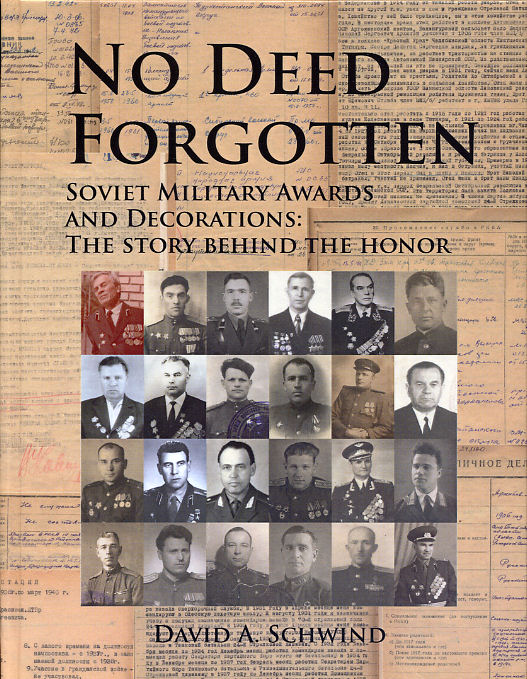
 0
0 -
Thanks for doing this Jeff! Welcome aboard!!
 0
0 -
He has been promoted (er..., I meant promoted himself) to Major-General. No wonder that with such a lack of respect your requests remain unanswered!!!
L.
Yes, I know, but for those around him, it is still "Colonel" -- modesty!
0 -
Lukasz: What is this medal? I have a uniform with the exact ribbon on it that I haven't been able to figure out what it is. Thanks! Dave
Going to The Source -- http://www.medals.lava.pl/pl/pl4c.htm#mmd -- it seems to be the Medal Za Zaslugi dla Obronnosci Kraju / Medal for Merit for Country Defense (post-1991 variety). The same ribbon was used for the 1966-91 medal.
0 -
Oh, I forgot the usual source references. Again, not much, not good, alas.
http://faculty.winthrop.edu/haynese/medals/morocco.html
http://www.omsa.org/photopost/showgallery.php?cat=569
http://www.4dw.net/royalark/Morocco/morocco15.htm
http://www.netdialogue.com/yy/Africa/Maroc/Maroc.htm
http://www.medals.org.uk/morocco/morocco.htm
http://www.coleccionesmilitares.com/cintas/cintasaf.htm#m and scroll to the two Moroccan pages
0 -
Midalit Al-Khidmat Al-Tawilat wa Al-Salook Al-Hasan / Long Service and Good Conduct Medal
Awarded for twelve years of unbroken service in the Omani military services without conviction on a serious charge. There is no provision for bars to represent subsequent periods of service.
The medal was created by Sultan Said bin Taimur and was originally issued in oxidized bronze, but this metal was soon replaced by the present bronze gilt version. With the accession of Sultan Qaboos bin Said in 1970, a new variety was introduced. At that point in time, the parallel name of the decoration in English was removed from the reverse. In 1972 the obverse legend, showing the sultan?s title was altered (this is the variety shown).


 1
1 -
Midalit Al-?Aid Al-Watani Al-Khamas ?Ashir Al-Majid / The Glorious Fifteenth National Day Medal
Awarded to commemorate the fifteenth anniversary of the accession of Sultan Qaboos to power, this medal was awarded to all ranks of the Omani armed forces and to employees of the Ministry of Defence (including civilians) serving on active duty on 18 November 1985.
Established: 1985. Designed by Wing Commander Andrew Kirk and manufactured by Spink and Son (London, England).
Obverse: A 37-mm circular frosted gilt medal with scalloped edges, in the center the Omani emblem, surrounded by the Arabic legand ?Al-Sultan Qaboos bin Sa?id Al-Ma?atum? or ?Sultan Qaboos bin Sa?id Al-Ma?athum?. Suspended by a curved, ornate straight bar. Interestingly, the plane in which the disk of the medal lies is slightly offset as compared to the suspension bar, apparently to simplify the mounting and wearing of the medal as a part of a group of medals.
Reverse: The number ?15? within an Arabic legend ?Glorious Fifteenth National Day Medal? and, below, ?1985? (C.E.).
Ribbon: 30 mm, red with equally spaced 1-mm stripes of green, white, green, white, green, white, green (four green, three white): 2.5 mm red, 1 mm green, 3 mm red, 1 mm white, 3 mm red, 1 mm green, 3 mm red, 1 mm white, 3 mm red, 1 mm green, 3 mm red, 1 mm white, 3mm red, 1 mm green, 2.5 mm red.
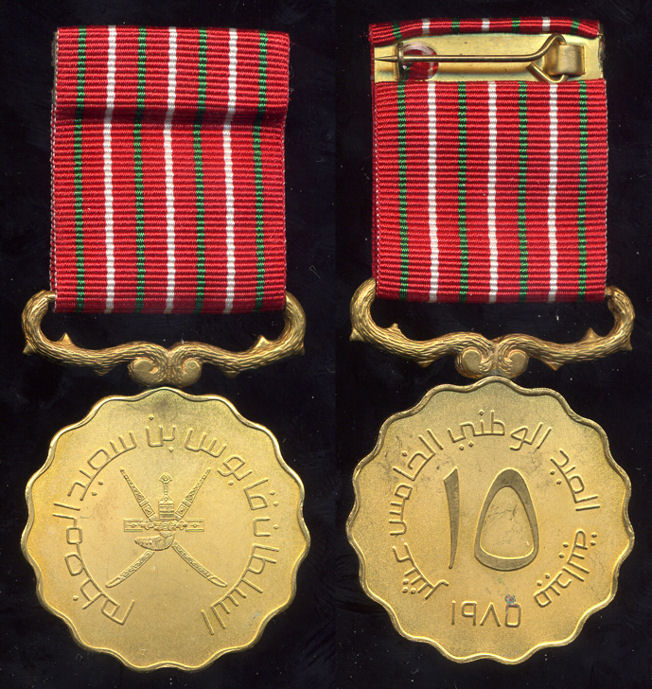

 1
1 -
Omani medals are often encounted in groups to foreigners loaned to the sultanate. For example, this Pakistani group:
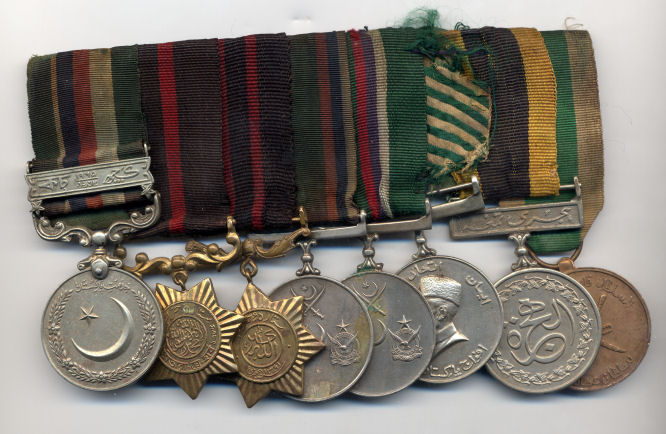

 1
1 -
Midalit Al-Salam Al-Omani / The Omani Peace Medal
Awarded in 1979 for one year of service after 1 July 1976 (the terminal date for the Dhofar clasp to the GSM). For those engaged in operations, a crown is added to the ribbon.
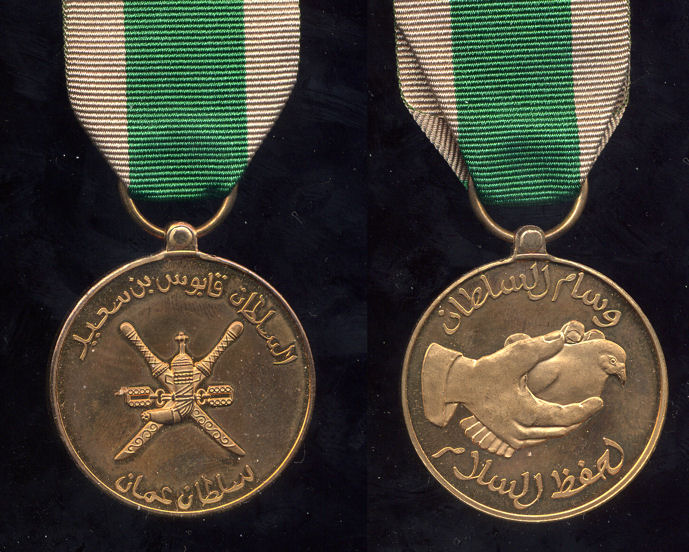

 1
1 -
Midalit Al-Sumood / The Endurance Medal
It was originally proposed that a medal be issued to represent victory and the end of organized resistance in the long war in Dhofar Province, for which the General Service Medal had been awarded. It is said that the sultan himself ruled out any ?victory? medal, as that misrepresented the sort of national suffering which the war had reprewsneted and that what ought to be commemorated, instead, was Al-Sumood, or ?Endurance?. The medal itself is, however, usually descibed even in English as the ?Al-Samood Medal?; I have adopted the literal English translation to convey the sense of national endurance which the sultan?s original directive sought to capture, and since the phrase ?Al-Samood? is totally meaningless to most non-Arabic-speakers.
The medal was awarded for thirty days of service in the period from 23 May 1965 to 2 December 1975. Note that this period of eligibility does not duplicate that of the General Service Medal.
Established: 1976. The medal was designed by Lieutenant Colonel Andrew Kirk and was manufactured by Spink and Son (London, England).
Obverse: Circular gilt medal, with the Omani national symbol in the center and an Arabic legend above and below. The medal is suspended from a ring suspender.
Reverse: The caligraphically rendered Arabic legend. Note that the medal is named here as a ?Wisam? or ?Order? and not as the officially reworded and refined title of a ?Midalit? or ?Medal?.


 1
1 -
Midalit Al-Khidmat Al-?Alamat / The General Service Medal
Originally intended to serve as a multi-purpose Omani general service medal (along British lines), for service of at least six weeks with a unit of at least company size, the medal has to date only been awarded with one clasp, for the Dhofar Rebellion. Despite apparent discussion to that effect, other clasps have not been instituted, based on the principle that active service is part of the normal duty of Omani armed forces personnel. There is, for example, some suggestion that a clasp was contemplated for the Second Gulf War.
Awarded for suppression of the Dhofar rebellion led by the Dhofar Liberation Organization (created 1964) and the Popular Front for the Liberation of Oman and the Arab Gulf (PFLOAG, created 1964), later (in 1974) merged and renamed as the Popular Front for the Liberation of Oman (PFLO); these groups received assistance from the People?s Democratic Republic of Yemen (PDRY or South Yemen).
The Dohfar clasp was awarded for fourteen days of consecutive service, thirty days of visits, or service abnormally terminated by wounds between 23 May 1965 and 20 June 1976 in those areas of the Dhofar Province and adjacent waters lying between longitude 52?00? and 56?30? E and latitude 16?30? and 18?00? N. Armed suppression assistance came to the Omani government from Iran, Jordan, and the United Kingdon and financial support came from India, Pakistan, Saudi Arabia, and the Trucial States (later, the United Arab Emirates).
About 1971, the obverse of the medal was redesigned with the name and title of Sultan Qaboos.
The die for the medal, with legends altered and the clasp omitted, was used (at short notice) for the Accession Medal of Sultan Qaboos in 1970.
Established: Struck by Spink & Son (London, England).
Obverse: Circular, gilt, Omani coat of arms in the center. Inscription in Arabic above and, below; as these inscriptions differ for the various issues of the medal, for Sultan Said and for Sultan Qabus. The medal is suspended from a straight-bar suspender. The clasp bears the name of the campaign in Arabic, ?Dhofar?; so far, only this single clasp seems to have been issued to this medal.
Reverse: Mountains above laurel branches, Arabic inscription above.
Ribbon: Equal of red, off-white, and green. The original ribbon design was intended to represent the three regiments of the Omani army: the Muscat Regiment (red), the Northern Frontier Regiment (green), and the Desert Regiment (sand), but there is also the interpretation that the colors represented blood, sand, and the green of the Jebel Akhdar region. When the ribbons were finally made, the sand-colored stripe came out very light, appearing ? ironically and embarassingly ? as if the ribbon represented the red-white-green colors of the opposing Dhofar Liberation Front. After Sultan Qaboos? accession to power, these colors were those used in the new Omani flag, so the embarsassment that ahd existed before was diminished. The ribbon of the Sultan Said medal may be seen carrying a bronze (or silver?) khanjar device or a bronze palm leaf representing bravery in battle.
Awards: The medal was also awarded to Iranian and Jordanian troops who served in this campaign; this came in addition to their own national awards. British troops were not allowed to receive both this medal and their own Campaign Service Medal 1962 with ?Dhofar? clasp; many British officers on long-term loan to Oman did, however, opt for the Omani medal.
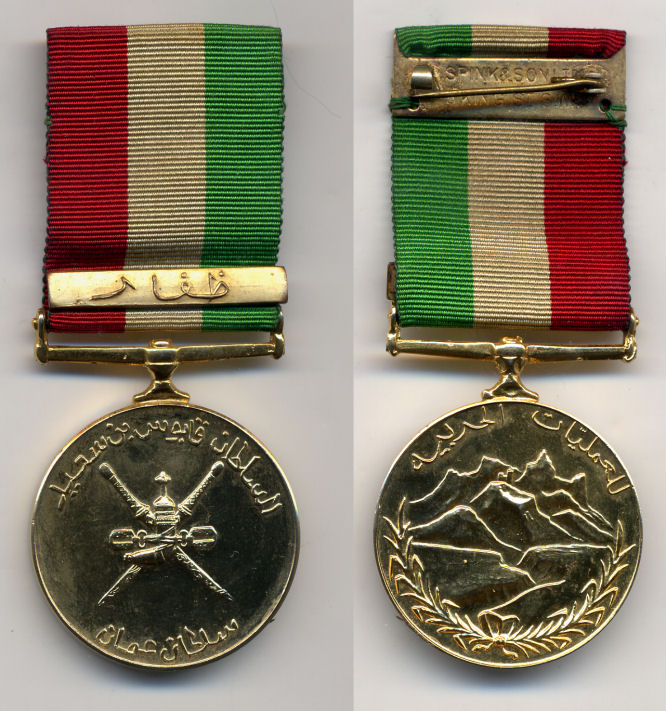

 1
1 -
Midalit Al-Hamalat / The Campaign Medal
Awarded to all officers and trained enlisted men (untrained personnel were excluded) who participated the the Jebel Akhdar War against the followers of Imam Ghalib bin Ali between 1 November 1958 and 1 February 1959.
Established: By Sultan Said bin Taimur in 1959. Manufactured by Spink and Son (London, England).
Obverse: A circular oxidized bronze medal. In the center, the Omani national emblem. Above and below, an Arabic legend. The medal is suspended from a swiveling straight-bar suspender (this is the only Omani medal to have a swiveling suspender). Bronze-gilt examples have been reported, but they seem to be merely trial or presentation specimens.
Reverse: A wreath surrounding the lower two-thirds of the Medal. Above, an Arabic legend and, in the center ??1378-79 H. [= 1958-59 C.E.] and ?JABAL AKHDAR / 1958-59?.
Ribbon: Diagonal stripes of green and red. This color scheme is said to represent the Jebel Akhdar (literally ?Green Mountain?) defanced with blood. The ribbon may be seen carrying a bronze (or silver?) khanjar device representing bravery in battle.


 1
1 -
Oman is unusual. It is unique. It is the only Arab State for which there is a good reference book. While it may, arguably, need updating, A. R. Tinson's Orders & Medals of the Sultanate of Oman (London: Spink, 1995; ISBN 0-907605-59-1) is a treat for the eyes and a feast of information. It is made all the richer by being bilingual (English and Arabic). It is a shame that other states have not emulated Sultan Qabus bin Said al-Mua'tham and supported such work.
Online, there is a bit, but not too much:
http://faculty.winthrop.edu/haynese/medals/oman.html
http://www.4dw.net/royalark/Oman/oman.htm
http://www.netdialogue.com/yy/Asia/Oman/Oman.htm
http://www.medals.org.uk/oman/oman.htm
http://www.omsa.org/photopost/showgallery.php?cat=604
http://www.coleccionesmilitares.com/cintas/cintasas.htm#o scroll to his two Oman pages
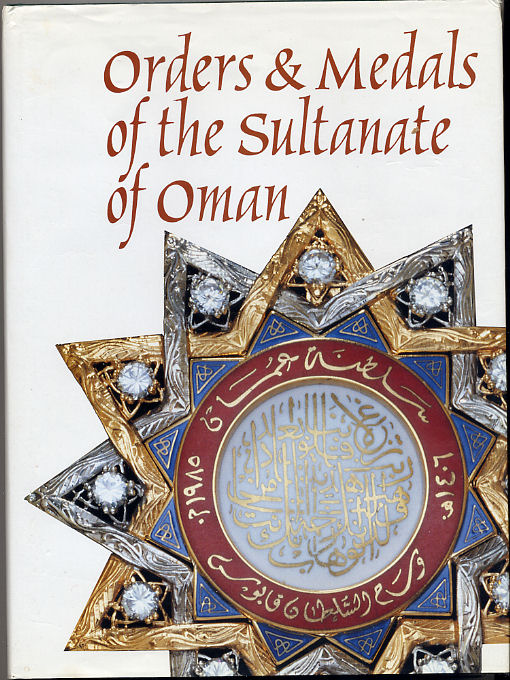

 1
1 -
Medal for the War with Ethiopia, 1964-65
For war January to April 1964.
Obverse: Bronze circular medal, 33 mm. Somali coat of arms and the inscription ?REPUBBLICA SOMALIA?.
Reverse: Inscription around the edge: ?CAMPAGNA SOMALO-ETIOPICA? and, in the center, ?GENNAIO / APRILE / 1964?, with two palm crossed branches at the bottom.
Ribbon: 35 mm, half yellow (left), half blue (right).


 1
1 -
While it may seem a strange "Arab" State, Somalia is a member of the Arab League, and so I include it here. As with many other Arab awards, good sources do not exist and online sources are extremely limited.
http://faculty.winthrop.edu/haynese/medals/somalia.html
http://www.medals.org.uk/somalia/somalia.htm
http://www.omsa.org/photopost/showgallery.php?cat=637
http://www.netdialogue.com/yy/Africa/Somali/Somali.htm
http://www.coleccionesmilitares.com/cintas/cintasaf.htm#a and go to page 4 of the general Africa page
0 -
Brevet Medal / Dahir Medal
Awarded to recipients of a ?Dahir de Satisfaction? or ?Brevet of Satisfaction?. Related to the Ouisam Alaouit Cherifien.
Obverse: 30 mm, silver(ed), a ball-pointed star in the center with a decorative background. In the center of the star, the Arabic legend. Suspended by ball and ring.
Reverse: Similar to the obverse, but with a parasol in the circular center of the star.
Ribbon: 38 mm, orange, with one broad (3 mm) and two narrow (1 mm) white center stripes: 14 mm orange, 1 mm white, 2.5 mm orange, 3 mm white, 2.5 mm orange, 1 mm white, 14 mm orange. Also reported as orange, with a series of narrow white ?stair-step? stripes, running from upper left to lower right across the ribbon.
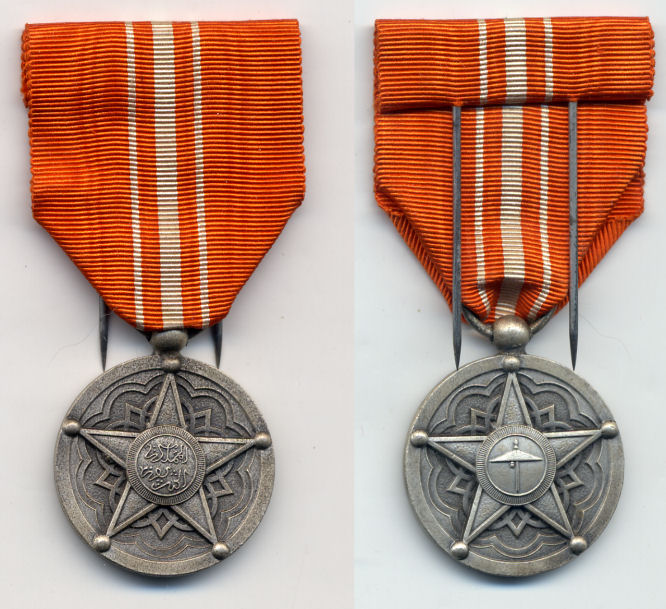

 0
0 -
Wissam al-Mehdawi / Order of Mehdi
Although created by the Moroccan rulers of Tetuan, this became an essentially Spanish colonial award, bestowed to reward actions that improved Moroccan-Spanish "inter-cultural understanding".
There are three separate varieties of the award, as detailed below.
Established: By Sultan Mulay al-Mehdi bin Ismail, Khalifa of Teutan, 18 August 1926. Revised bu Vizirial Dahirs of 10 May 1937 and 6 August 1945. Known to have been manufactured by Gardino (Rome, Italy).
Obverse: A six-pointed gold dark- and light-blue enameled star. In the center, a golden sun rising from a green sea.
Reverse: Plain, but with a circular central medallion, enemaled blue with the legend in Arabic.
Ribbon: Blue-green with a white center stripe. The medal is often worn suspended from the familiar Spanish open rectangular clasp.
first variety, 1926-37:
- gold star ? a gold breast star (worn on the left breast)
- silver star ? a silver breast star (worn on the left breast)
- gold badge ? a gold breast badge
- silver badge ? a silver breast badge
- bronze badge ? a bronze breast badge
second variety, 1937-45:
- grand collar ? a collar chain and badge
- grand cross ? a gold breast star (worn on the left breast), the same as the gold star of the previous variety
- grand officer ? a silver breast star (worn on the left breast), the same as the silver star of the previous variety
- commander ? a gold breast badge, the same as the gold badge of the previous variety
- officer ? a silver breast badge, the same as the silver badge of the previous variety (this is the badge shown below?)
- knight ? a bronze breast badge, the same as the bronze badge of the previous variety
third variety, 1945-56:
men?s division:
- grand collar ? a collar chain and badge, the same as the grand collar of the previous variety
- grand cross ? a gold breast star (worn on the left breast), the same as the grand cross of the previous variety
- grand officer ? a silver breast star (worn on the left breast), the same as the grand officer of the previous variety
- commander ? a gold breast badge, the same as the commander of the previous variety
- officer ? a silver breast badge, the same as the officer of the previous variety (this is the badge shown below?)
- knight ? a bronze breast badge, the same as the knight of the previous variety
women?s division:
- grand cross ? a sash (?narrow?, worn over the ??? shoulder) and sash badge
- broad band ? commander?s gold badge worn on a ?broad? bow ribbon
- band ? commander?s gold badgeworn on a ?narrow? bow ribbon
- bow ? officer?s badge worn on a bow ribbon
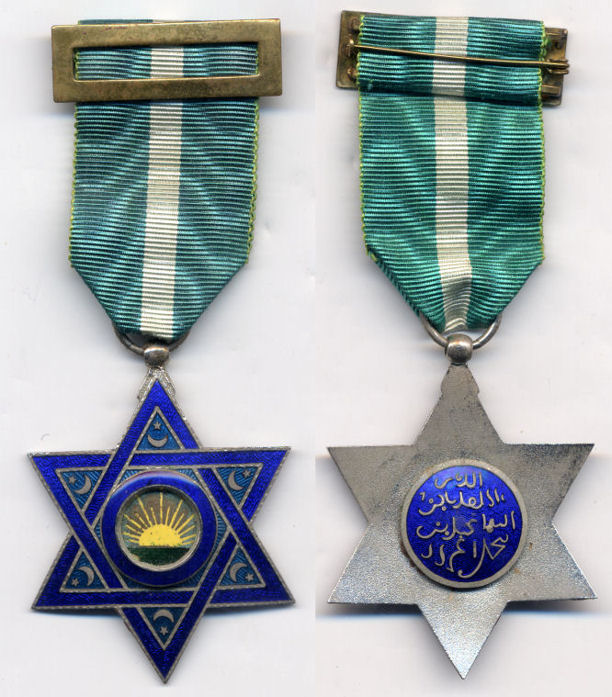

 0
0 -
Wissam al-Arch / Ordre de Tr?ne / Order of the Throne
Awarded for civil and military merit.
There is a statutory limitation on the number of recipients allowed in each class and membership in a lower class is a requirement for appointment to the next higher class.
Established: By King Hasan II 16 May 1963. Revised 7 June 1965, 14 December 1966, and 19 April 1967.
Obverse: A silver-gilt rayed pentagon (point downwards). On this, a gilt wavy five-pointed star and, on that, a five-pointed green-enameled Moroccan star with the gilt Moroccan coat of arms in the center. Between the points of this last star, the Arabic legend ?Al-Arch? or ?The Throne?.
Ribbon: Red with narrow green edge stripes.
- exceptional class ? a sash (worn over the ??? shoulder), sash badge, and breast star (with gilt rays, worn on the left breast)
- first class ? a breast star (with silver rays, worn on the left breast)
- second class ? a neck badge
- third class ? a breast badge in gilt
- fourth class ? a breast badge in silver (shown below)
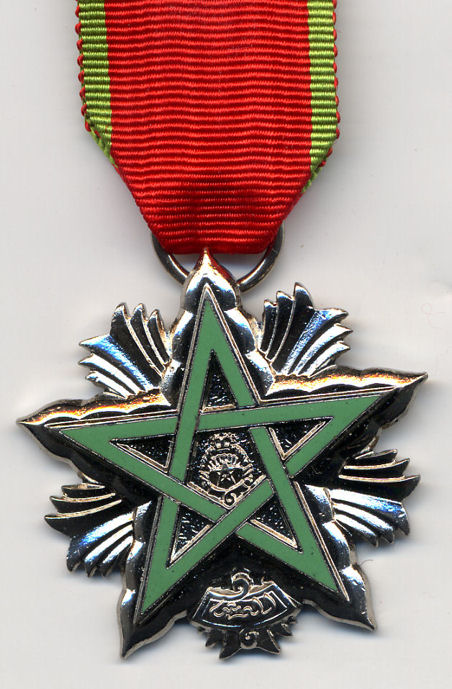

 0
0 -
I hope Dave doesn't mind if his lovely and inspirational post gets hijacked as the springboard for a more general Morocco thread.
First, some general information from my notes on the
Wissam Alaouit Cherifien / Order of the Sharifian Alawaid Dynasty
Awarded for civilian or military merit. The lowest classes had to be conferred first and awards of higher classes were by gradual promotion. Under normal circumstances, Moroccans must have served the State (or French protectorate) five years before they could be nominated.
A lesser diploma of honor, the Dahir de Satisfaction, was affiliated to the order as a junior class, but subordinate to the order.
The order was freely bestowed to French military troops with at least three years of service in Morocco, to other foreigners with five years of service; promotion could be achieved only after three years in a lower class. It was also awarded freely to senior allied officers during WWII.
After 19?? (the second badge), limits were imposed on the maximum numbers of holders of each class, and holders could not be elevated until openings appeared.
Established: By Sultan Yusuf, 2 Sapher 1331 (11 January 1913), to replace the Nishan Hafidien. Essentially absorbed later as a French colonial order.
Obverse: A white-enameled ball-pointed five-pointed star with green-enameled wreaths in the angles. The first badge had the text of the shahadat in the points of the star; the star is plain for the second badge. In the red enameled center is the Arabic inscription: His Majesty Youssef?. Suspended by a gold wreath.
Reverse: Gold, the red-enameled monogram of the ruler, the red Cherefien umbrella.
Ribbon: First ribbon: orange. Second ribbon: Pale orange moir? with thin white edge stripes.
It is a five-class (French style) order plus the affiliated medal.
0 -
Al-Fatah Medal
Also known as the ?Medal for the 1969 Revolution?.
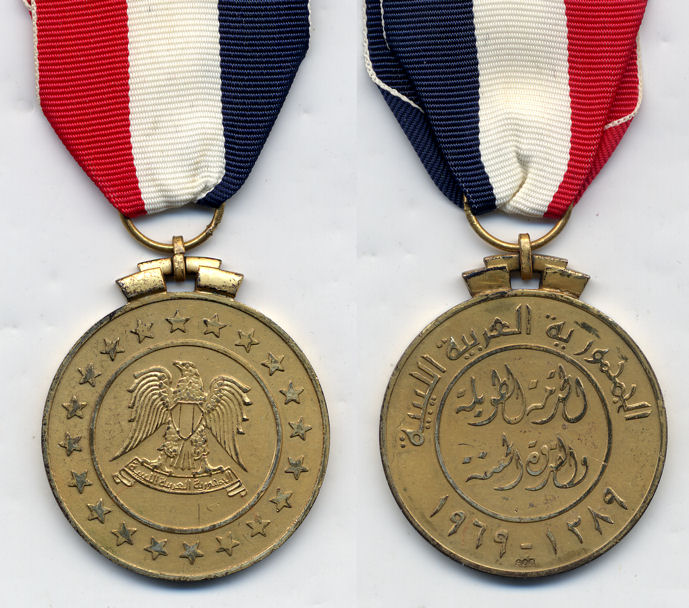

 1
1




ARAB MEDALS -- Iraq
in Middle East & Arab States
Posted
Very nice, for a policeman!